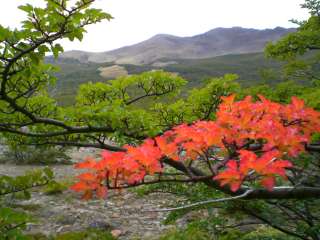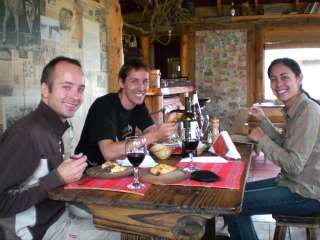Uh Oh, Uco
Saturday, March 31st, 2007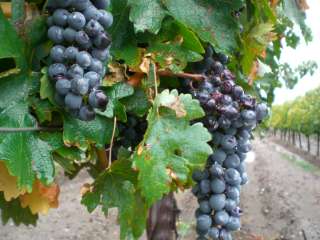
We found a small premium wine tour with Ampora Tours to the Uco Valley, the supposed “next Napa Valley” and home to the highest vineyards in the world at 1,100 to 1,300 meters. The sandy soil, sunny days, cool nights, lack of rain, and abundant spring water all create perfect conditions for great grapes with concentrated sugars and thick skins. After picking up the three other tourists we visited three vineyards of different sizes with our guide.
The tour was nearly continuous hilarity from the beginning and wine only added to the Canadian humour. Upon finding out the other tourists in the group were staying at the Park Hyatt, we started hypothesizing who would stay at this elite bastean of elegant class. I guessed Americans and Janet guessed Germans. Both wrong: two youngish Canadian women, Sharon and Linda from Vancouver, travelling on their oil and gas money. They vowed revenge if we published this picture of them. So be it.
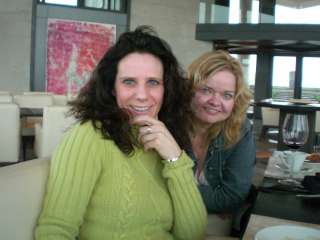
The first vineyard, Estancia Ancon, was the smallest vineyard with a production of 90,000 bottles. The Grande Reserve de la Familia blend of cabernet sauvignon, malbec and pinot noir, a limited edition of 6,000 bottles, was our favorite wine of the day, although our palettes were still fresh at the time. The atypical blend had a pleasant smoothness from the pinot noir and oak. The property’s villa can also accommodate tourists for an undisclosed sum.
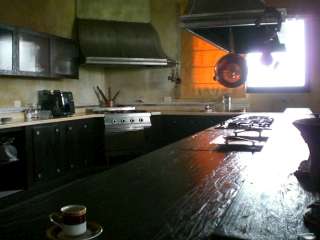 Andeluna, the second vineyard, was a little bigger. The suburban-country tasting room was warm, though a little contrived. We tried five wines with the 2005 Malbec and the 2003 Pasionado Blends being our favorites.
Andeluna, the second vineyard, was a little bigger. The suburban-country tasting room was warm, though a little contrived. We tried five wines with the 2005 Malbec and the 2003 Pasionado Blends being our favorites.
The last vineyard was O. Fournier. The owners told the architects that visitors should either hate it or love it, but never forget it. The ominous concrete structure fulfilled that mandate; it kind of looks like an airport terminal. To avoid pumping the wine, the lowest level is 20 meters underground. Whole grapes are crushed at the top level, then slide down to the fermentation vats on the next level, and then are aged in oak barrels on the last level. We toured the cellar on catwalks where we also viewed enourmous pieces of art from a local artist.
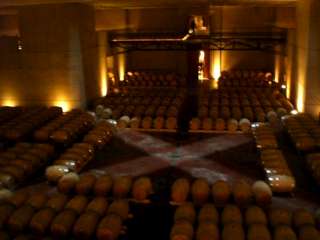
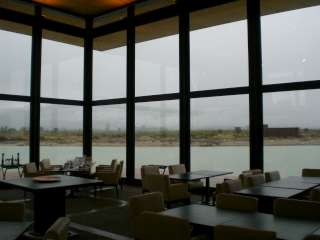
A highlight of the tour was the four course lunch at the winery’s by-appointment-only-restaurant. A colourful trio of warm soups—potato, pumpkin with pepper and greensquash with spring onion—were served in shot glasses and followed up with a few simple treads of julienned peppers and eggplant with oil and salt. We were surprised to find the Malbec held up to the red wine vinegar in the salmarejo, a cold gazpacho-like soup, which followed. Alfa Crux, a wine we tasted at Vines of Mendoza, accompanied the requisite beef entree. The dining room’s six meter high windows were intended to provide grand views of the Andes, but instead the clouds provided a white backdrop which only partially cleared.
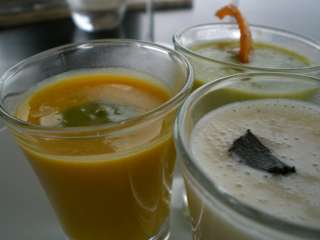
After a day of wine we were noisely cracking jokes and laughing and the two Canadian women setting the pace. As the only male in a party of six, I couldn’t offset the natural tendency of the drunk women to get rowdy and talk about men. Somehow, one of the owners’ father at the next table managed to fall asleep over the ruckus at the next table. Fortunately, the ladies directed most of their interest to the driver, the waiter and the security guard, who one hoped would require sexual favors in place of a lost receipt.
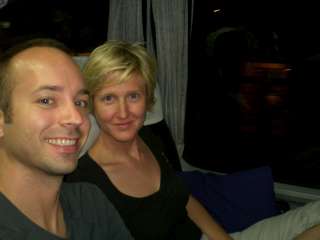 Thanks to
Thanks to 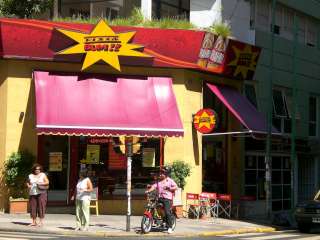
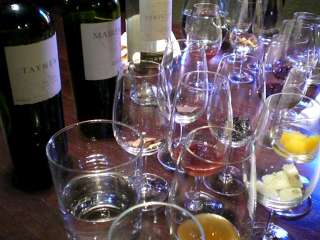 The special tasting room (!!) was prepared with three different, non-blended local wines: a Torrontes, a Bonarda and a Malbec. However, in addition to the wines, there were tasting glasses filled with the flavours that one is meant to experience in each wine. For example, the glass of Bonarda was accompanied by a glass each of earth, dried leaves, quince jam, and pepper. So, after one swirls and takes notes on the wines appearance, one is meant to sniff the aroma and compare it to the raw elements. How much fun is THAT!
The special tasting room (!!) was prepared with three different, non-blended local wines: a Torrontes, a Bonarda and a Malbec. However, in addition to the wines, there were tasting glasses filled with the flavours that one is meant to experience in each wine. For example, the glass of Bonarda was accompanied by a glass each of earth, dried leaves, quince jam, and pepper. So, after one swirls and takes notes on the wines appearance, one is meant to sniff the aroma and compare it to the raw elements. How much fun is THAT!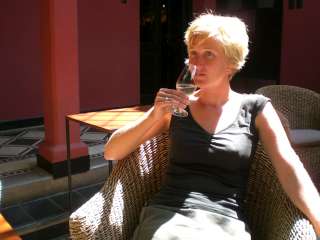 In my present state of mind*, I find it hard to imagine a better place in the world than Mendoza. They get 300 days of sun a year, the city is filled with huge, gorgeous trees, parillas (Argentine BBQ restaurants which universally serve gargantuan steaks) hover around almost every corner, and they are surrounded by wineries. Oh, and they’re within spitting distance of the Andes, not that I would ever spit wine.
In my present state of mind*, I find it hard to imagine a better place in the world than Mendoza. They get 300 days of sun a year, the city is filled with huge, gorgeous trees, parillas (Argentine BBQ restaurants which universally serve gargantuan steaks) hover around almost every corner, and they are surrounded by wineries. Oh, and they’re within spitting distance of the Andes, not that I would ever spit wine.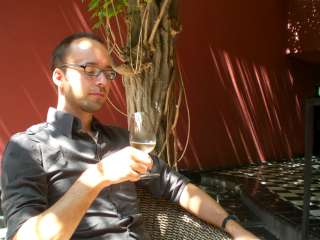 Anyway, I could go on and on about the wine but will limit myself here to talking about one particular wine tasting facility: Vines of Mendoza. I don’t really know how to label this place; it’s sort of a wine club, tasting room, wine-tour arranger, enthusiasts’ meeting place, wine promoter type place. (They make money by exporting local wines to Europe and America.) But for us, it’s just a great, relaxed place to go to taste, and learn about wine.
Anyway, I could go on and on about the wine but will limit myself here to talking about one particular wine tasting facility: Vines of Mendoza. I don’t really know how to label this place; it’s sort of a wine club, tasting room, wine-tour arranger, enthusiasts’ meeting place, wine promoter type place. (They make money by exporting local wines to Europe and America.) But for us, it’s just a great, relaxed place to go to taste, and learn about wine.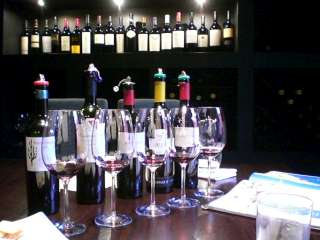 The hour and a half that followed was magnificent. We tasted five of Argentina’s Best wines, complete with an educated and friendly host who walked us through the regions, the varietals, the aging, the aromas and the tasting. (I’m edumacated in the wine, now.) After being so long in Asia without a drop of decent wine to be found, this was an absolutely exquisite way to spend the afternoon.
The hour and a half that followed was magnificent. We tasted five of Argentina’s Best wines, complete with an educated and friendly host who walked us through the regions, the varietals, the aging, the aromas and the tasting. (I’m edumacated in the wine, now.) After being so long in Asia without a drop of decent wine to be found, this was an absolutely exquisite way to spend the afternoon.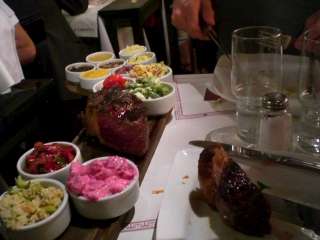 Two random couples we met raved about La Cabrera, a barbeque restaurant in Buenos Aries, one fellow saying he would return to BA just to go there. We showed up at 9pm, an early arrival by Argentinian standards, just to ensure we could get a seat without waiting, which we barely managed.
Two random couples we met raved about La Cabrera, a barbeque restaurant in Buenos Aries, one fellow saying he would return to BA just to go there. We showed up at 9pm, an early arrival by Argentinian standards, just to ensure we could get a seat without waiting, which we barely managed.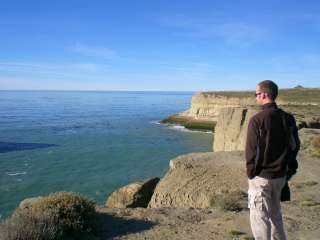 We stopped first at a lookout over the ocean and the island owned and operated by the migratory cormorants. Guano was mined here for European fertilizer until about 1930 and judging by the smell, the birds have worked hard since then to replenish the supply. Fortunately, we had our trusty binoculars and so were able to see a fair bit of avian activity before setting up our cold breakfast in the picnic hut upwind of the island. After breakfast, we decided to take a crack at seeing los penguinos. I was not optimistic because it was so warm, I thought for sure they’d be on their way someplace cooler now and would have abandoned their colony. Plus, the hike through the desert to reach the colony did not inspire confidence for a viewing. This sign was so randomly placed as to seem a joke.
We stopped first at a lookout over the ocean and the island owned and operated by the migratory cormorants. Guano was mined here for European fertilizer until about 1930 and judging by the smell, the birds have worked hard since then to replenish the supply. Fortunately, we had our trusty binoculars and so were able to see a fair bit of avian activity before setting up our cold breakfast in the picnic hut upwind of the island. After breakfast, we decided to take a crack at seeing los penguinos. I was not optimistic because it was so warm, I thought for sure they’d be on their way someplace cooler now and would have abandoned their colony. Plus, the hike through the desert to reach the colony did not inspire confidence for a viewing. This sign was so randomly placed as to seem a joke.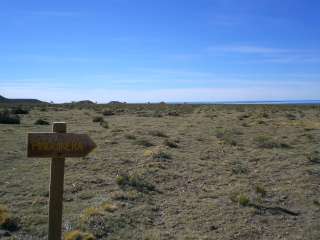
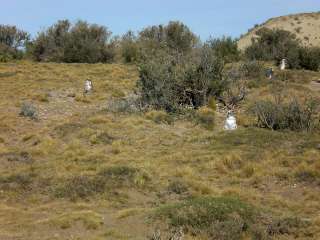
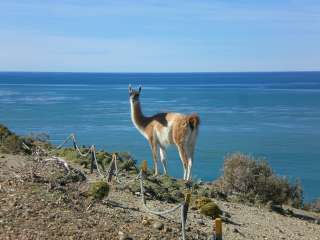
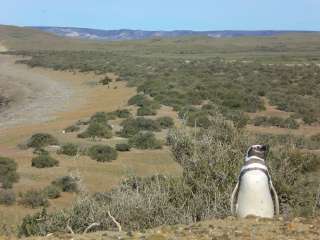
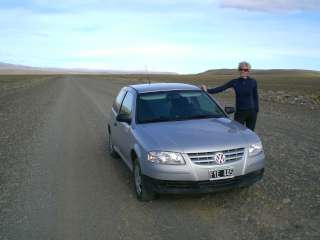 So, we rented a cute little Volkswagen, bought a map and a bunch of groceries and fired out onto the 297km gravel road that forms the majority of the connection between El Calafate and Puerto Santa Cruz. I don’t think I’ve ever been so much in the middle of nowhere as we were when we hit that gravel road.
So, we rented a cute little Volkswagen, bought a map and a bunch of groceries and fired out onto the 297km gravel road that forms the majority of the connection between El Calafate and Puerto Santa Cruz. I don’t think I’ve ever been so much in the middle of nowhere as we were when we hit that gravel road. 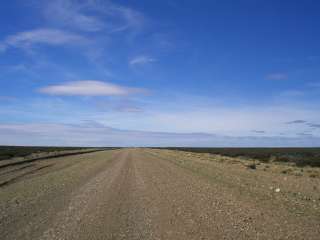
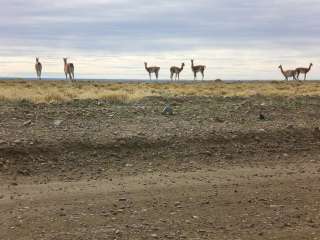 There were the usual suspects of rabbits and sheep, skunks and hawks, but there were also herds and herds of guanacos (sort of like llamas but less fuzzy) and a large bird whose name I don’t know but who looks and runs like an ostrich. Most fantastic of all, we saw a condor. I think we are exceptionally lucky to have spotted it on the side of the road right next to the huge river valley; it took off and floated on a thermal wind up and over and around our car for about 5 minutes. That bird is astonishingly large and to see it fly like that was amazing; this picture, nor my words, can hardly do it justice. We were agog.
There were the usual suspects of rabbits and sheep, skunks and hawks, but there were also herds and herds of guanacos (sort of like llamas but less fuzzy) and a large bird whose name I don’t know but who looks and runs like an ostrich. Most fantastic of all, we saw a condor. I think we are exceptionally lucky to have spotted it on the side of the road right next to the huge river valley; it took off and floated on a thermal wind up and over and around our car for about 5 minutes. That bird is astonishingly large and to see it fly like that was amazing; this picture, nor my words, can hardly do it justice. We were agog.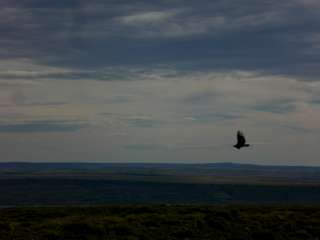
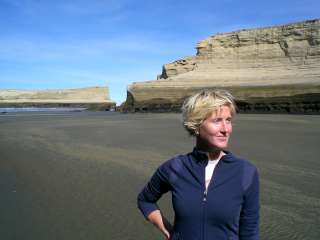 At any rate, this allowed us to spend one full, sunny day at the stunning national park next door and also forced us to sleep in the car that night. It wasn’t nearly as bad as I thought it would be: a quiet campground, a great view, a couple bottles of wine with our picnic… who knew I’d ever be so happy to sleep in a Golf?
At any rate, this allowed us to spend one full, sunny day at the stunning national park next door and also forced us to sleep in the car that night. It wasn’t nearly as bad as I thought it would be: a quiet campground, a great view, a couple bottles of wine with our picnic… who knew I’d ever be so happy to sleep in a Golf?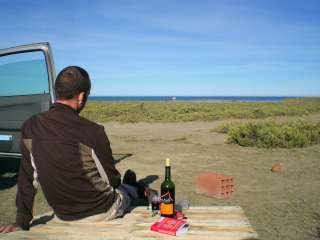
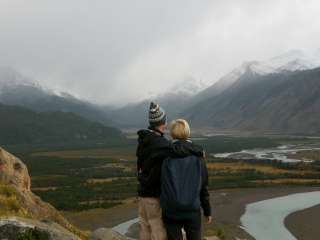 n Argentina have everything ready for us. The starting point for us (and piles of other people) is El Calafate, a town of 18,000 people on the shore of a windy, glacial – and what must be terribly cold in the winter – Lake Argentino. On a clear day, with the Andes sparkling in the background, and the lake reflecting some perfect version of cloudy aquamarine, it reminds me of a blend of Banff and Lake Louise. I felt so at home here, and not just because of the steak nor the quaint stores and chocolate shops on Main Street nor the chilled air or fresh breeze, it was the people that reminded me of home. Half-tourist, half-outdoor folk, with a lot of hotels and restaurants to keep us all mingling.
n Argentina have everything ready for us. The starting point for us (and piles of other people) is El Calafate, a town of 18,000 people on the shore of a windy, glacial – and what must be terribly cold in the winter – Lake Argentino. On a clear day, with the Andes sparkling in the background, and the lake reflecting some perfect version of cloudy aquamarine, it reminds me of a blend of Banff and Lake Louise. I felt so at home here, and not just because of the steak nor the quaint stores and chocolate shops on Main Street nor the chilled air or fresh breeze, it was the people that reminded me of home. Half-tourist, half-outdoor folk, with a lot of hotels and restaurants to keep us all mingling.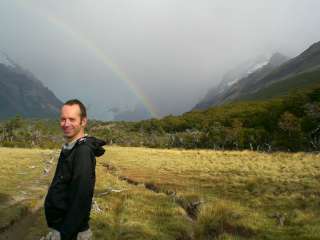 In the three days we were there, the sun shone for approximately five minutes, and the rest of the time it was either grey sky with gale force winds or rainy or both. Mostly both. However, with such a short time there, we couldn’t afford to wait for the weather and so we set out with a woman we met from Iowa and a fellow from Sydney to see Cerro de Torre. It turned out to be a lovely hike through forested area, which kept the wind and rain at bay, and we come upon some gorgeous views…
In the three days we were there, the sun shone for approximately five minutes, and the rest of the time it was either grey sky with gale force winds or rainy or both. Mostly both. However, with such a short time there, we couldn’t afford to wait for the weather and so we set out with a woman we met from Iowa and a fellow from Sydney to see Cerro de Torre. It turned out to be a lovely hike through forested area, which kept the wind and rain at bay, and we come upon some gorgeous views…